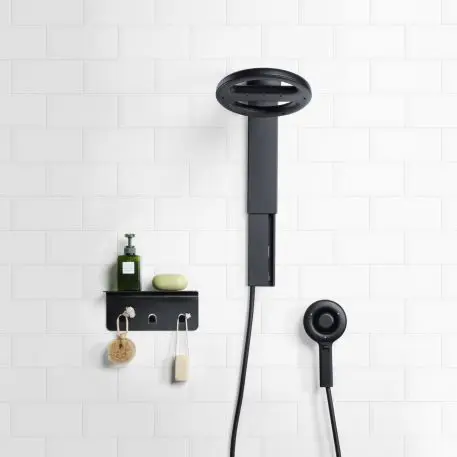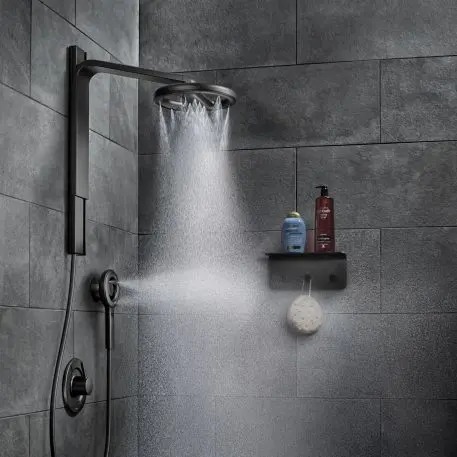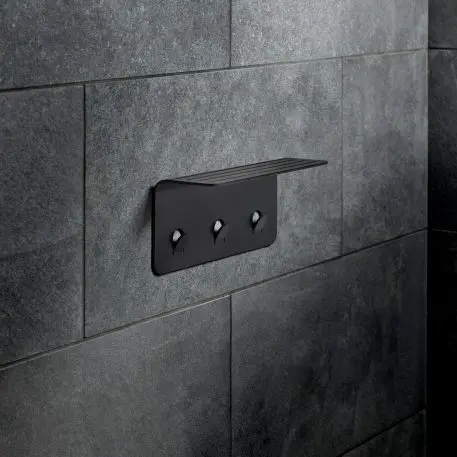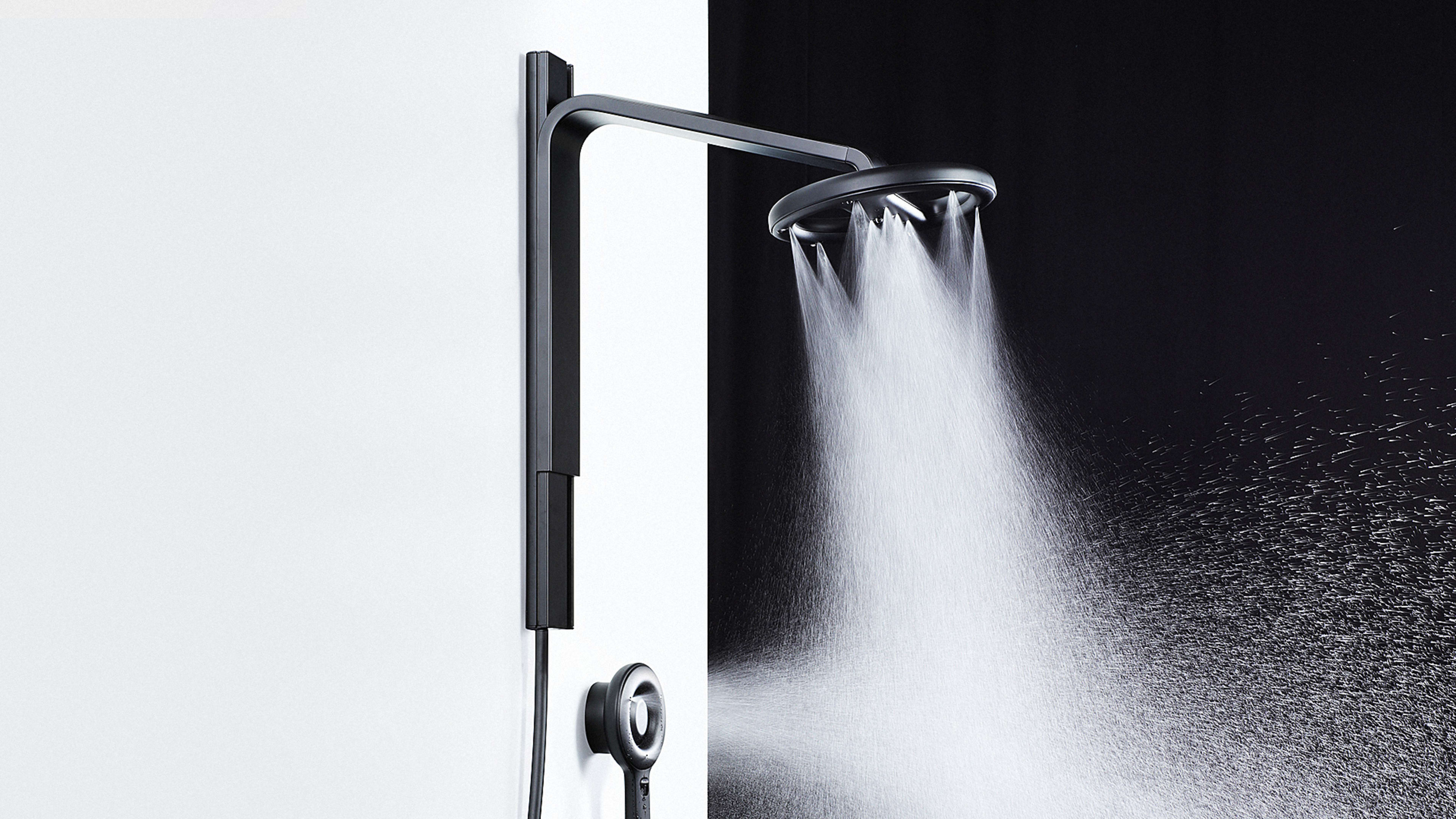I close my eyes, and I can picture five arms reaching inside my shower curtain, spritzing my body with hot hairspray. I’m definitely getting wet, but it barely feels like water. When I open my mouth to catch the aerosol, it seems to evaporate as it hits my tongue.
I’ve just installed the Nebia 2.0, a $500 luxury shower system that uses 50% to 65% less water than a typical shower–and I’ve instantly bought into all of the hype.
Nebia was born as a prototype designed to cut down on water usage in Mexico’s largest athletic club chain, where one of the company’s cofounders, Carlos Gomez Andonaegui, was CEO at the time. Soon, it made its way as a beta product onto the campuses of Google and Apple, with the fledgling startup eventually wooing prestigious Silicon Valley investors including Tim Cook and Eric Schmidt.
It promised the experience of an extravagant shower without diverting Niagara Falls to get there. It’s just the sort of pitch that resonated with the liberal power brokers of the Bay Area and our own Innovation by Design Awards. When it finally hit Kickstarter as a real product in 2015, the shower system raised over $3 million. Nebia has sold 16,000 units to date.

The company is debuting its second-generation product on Kickstarter today. The reengineered version sprays warmer water at higher pressure than the first model–it also comes in black. Nebia is also launching a $40 stick-on shelf with a specially formulated 3M adhesive that lets you stick it onto your shower wall.
This time, it’s backed by a new wave of partnerships, including Moen and 3M, along another round of all-star investors, Joe Gebbia (cofounder of Airbnb), James Park (CEO of Fitbit), and Barry Sternlicht (CEO of Starwood Capital Group).
With an undisclosed amount of new funding, Nebia wants to do two things: continue to build its brand name in the luxury shower space and, eventually, scale its opulent, low-flow technology to less expensive products for more people.
“[Nebia 2.0] remains a premium product, and we’re okay with that,” says CEO Philip Winter, likening the company’s future strategy to the way Tesla brought costs down to build the Model 3. “We’re charting a course to make it more accessible and open around the world.”

What’s different
So what’s new with the Nebia 2.0? For the most part, it’s the same system it always was. Its core is an aluminum tower that slides up and down depending how tall you want your shower to be. It still features a wand that sticks to the shower wall with a powerful magnet, serving as a body sprayer most of the time. And it’s the only shower system on the market that can be installed without screws or drilling. An impressive combination of tools and video tutorials means that most people should be able to install the Nebia within its 10-minute claim (I’m certain I could have, though I opted to make a quick call to Winter rather than dig through FAQs when I hit one hiccup).

As Winter explains, Nebia was the first company to bring water atomization to showers. Atomization technology turns fluids into tiny droplets, and it’s commonplace in distributing pesticides in the agriculture industry, or injecting fuel into car engines–pretty much any place you want a bit of precious liquid to go a long way. Its cost, however, is heat. These tiny droplets lose their warmth quicker than big droplets do. So in the split second it takes for the droplets to leave the showerhead, they can arrive feeling cool.
Nebia’s technical innovation lies inside about an inch-long run of nozzles that are built in the showerhead. Using thermodynamic modeling software, the team was able to refine the design between 1.0 and 2.0 to maximize heat retention. One secret is that there isn’t just one nozzle repeated for every point of spray–the Nebia uses several nozzle designs, five of which are patented, in concert.
“The way we’ve mitigated [cooling]–since it’s physics, you can’t reverse it–was using a variety of spray types, droplet velocities, droplet sizes, and spray angles,” says Winter. “It’s a combination, the way the droplets overlap and coalesce, that makes it a good experience. And that has required a ton of iteration–a lot more than we thought was necessary.”
I haven’t tried Nebia 1.0, but the somewhat Frankensteined 2.0 beta unit I was sent was plenty hot in my small shower stall–though it definitely needed to run for about a minute to heat up first, because there’s no way to avoid the mist once it starts (like you would with a typical showerhead).
The heat is also controllable through the device’s UX, rather than your shower knob. Because the heat has a very quick falloff from the showerhead itself, you can also raise or lower the water temperature through a small tug or push of the showerhead on its track, moving its warmth closer or further from your skin. Along the same lines, you can angle the wand (which doubles as your body sprayer) in almost any direction you like, since it sits on its post via magnetism. In any case, I found myself interacting with the Nebia as a changeable, ergonomic machine–more like I would a piece of furniture than a typical showerhead.

New partnerships
While Nebia 2.0 is simply a refinement of the first version–it also comes in black!–Winter believes that the company’s future isn’t in selling expensive showers to tens of thousands of people of relative means, but scaling it to become something of a middle-class splurge.
“What’s remarkable is that almost no one knows what brand, let alone model, of showerhead we use everyday,” says Winter. “People are more likely to know what kind of vacuum they have. ‘I have a Dyson 7z94!’ Why is that? There’s this huge opportunity–people love a great shower.”
The real key to building the Nebia brand may, ironically, be through deals with another brand: its new investing partner, Moen.
Nebia and Moen, which sells cheaper plumbing hardware than competitors like Kohler and sells more faucets in the U.S. than any other company, began talking a bit over a year ago, and the relationship culminated when the president of Moen’s parent group, Nicholas Fink, flew out to Nebia’s San Francisco office to try the shower for himself.
“He popped in the shower, spent half an hour jumping between Nebia 1.0 and a prototype of 2.0,” Winter recounts. “He totally loved it.” (Most of Winter’s stories–from wooing early partners with Nebia showers the team pirate-installed into rented hotel rooms to pitching at Y Combinator–culminate in the words, “and then they hopped in the shower and loved it!”)
Moen is leading Nebia’s series A funding round, as well as both consulting and collaborating on future products, while Nebia will share some core components off the factory line with Moen, which should reduce Nebia’s production costs.
So while Nebia 1.0 and 2.0 are premium shower systems aimed at a very select portion of the population, the company is poised to develop products that more of us will be able to afford soon. It’s easy to imagine a Nebia shower system in the $200 range being the same sort of irresistible, domestic impulse splurge as a Dyson vacuum or Nest thermostat–and Winter agrees.
“These first two products are about validating, confirming a market, building a knowledge and know-how,” says Winter. “We don’t want to just build a luxury brand.”
Recognize your brand’s excellence by applying to this year’s Brands That Matter Awards before the early-rate deadline, May 3.
